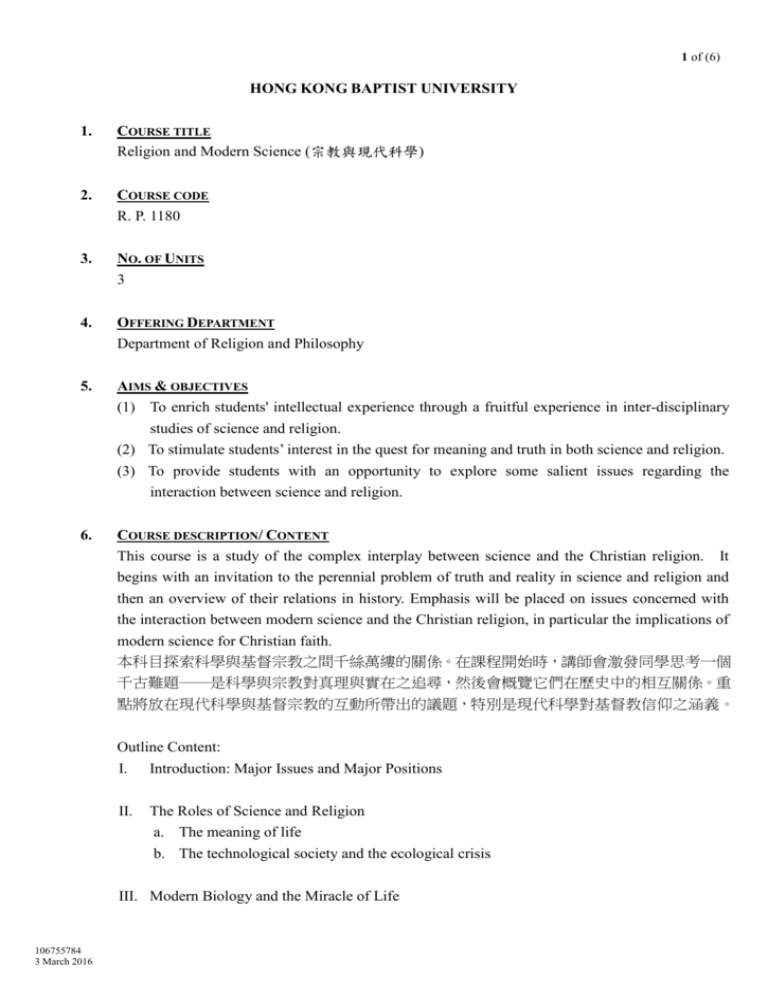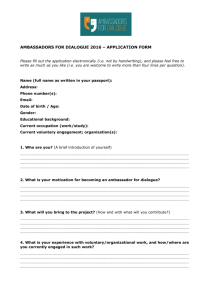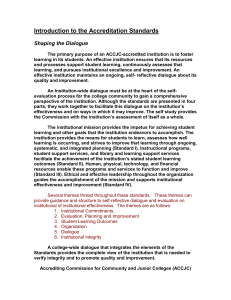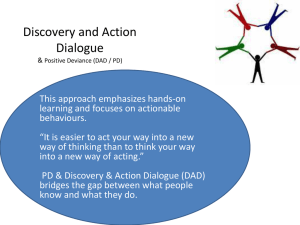HONG KONG BAPTIST UNIVERSITY
advertisement

1 of (6) HONG KONG BAPTIST UNIVERSITY 1. COURSE TITLE Religion and Modern Science (宗教與現代科學) 2. COURSE CODE R. P. 1180 3. NO. OF UNITS 3 4. OFFERING DEPARTMENT Department of Religion and Philosophy 5. AIMS & OBJECTIVES (1) To enrich students' intellectual experience through a fruitful experience in inter-disciplinary studies of science and religion. (2) To stimulate students’ interest in the quest for meaning and truth in both science and religion. (3) To provide students with an opportunity to explore some salient issues regarding the interaction between science and religion. 6. COURSE DESCRIPTION/ CONTENT This course is a study of the complex interplay between science and the Christian religion. It begins with an invitation to the perennial problem of truth and reality in science and religion and then an overview of their relations in history. Emphasis will be placed on issues concerned with the interaction between modern science and the Christian religion, in particular the implications of modern science for Christian faith. 本科目探索科學與基督宗教之間千絲萬縷的關係。在課程開始時,講師會激發同學思考一個 千古難題──是科學與宗教對真理與實在之追尋,然後會概覽它們在歷史中的相互關係。重 點將放在現代科學與基督宗教的互動所帶出的議題,特別是現代科學對基督教信仰之涵義。 Outline Content: I. Introduction: Major Issues and Major Positions II. The Roles of Science and Religion a. The meaning of life b. The technological society and the ecological crisis III. Modern Biology and the Miracle of Life 106755784 3 March 2016 2 of (6) a. Are creation and evolution incompatible? b. Contemporary debate about the evolutionary theory IV. Modern Physics and the Mind of God a. Big Bang Theory and Creatio ex Nihilo b. The Anthropic Principle and the new design argument c. Other points of contact: order, intelligibility of nature, etc. V. Science and Religion: Methodological Comparison a. Evaluation of Scientism b. Science: its rationality and its limits c. Religion: faith or reason? VI. Other Issues (Due to limitation of time, selected topics of the following will be covered at the discretion of the instructor.) a. Miracle and God's Interaction with the World b. Historical Interactions between Science and Religion (1) Cases of conflict: Galileo and Darwin (2) The rise of modern science VII. Conclusion: Religion and Science in Dialogue 7. COURSE INTENDED LEARNING OUTCOMES (CILOS) CILO By the end of the course, students should be able to: CILO 1 Explain the recent developments in the science-religion dialogue. CILO 2 Assess the merits and limitations of the major models of science-religion dialogue. CILO 3 Appreciate the creative tensions between science and religion. 8. TEACHING & LEARNING ACTIVITIES (TLAS) CILO CILO 1 106755784 3 March 2016 TLAs The students will: actively participate in lectures which introduce comprehensively the recent developments in the science-religion dialogue. read selected articles on the recent developments in the science-religion dialogue, and then explain the basic ideas of those readings to the whole 3 of (6) tutorial group and lecturer. CILO 2 CILO 3 9. respond to questions of the classmates during tutorial sessions concerning their understanding of the recent developments in the science-religion dialogue. write a term paper to assess the debate on a controversial topic in the science-religion dialogue. answer essay questions in the final examination about the recent developments in the science-religion dialogue. actively participate in lectures which discuss the merits and limitations of the major models of science-religion dialogue. read selected articles on a certain controversial topic in the science-religion dialogue from the perspectives of those major models, and then explain their assessment of those positions to the whole tutorial group and lecturer. respond to critical questions of the classmates during tutorial sessions concerning their positions on that controversial topic in the science-religion dialogue. write a reflection report after the tutorial presentation to explain their stance on the controversial topics. write a term paper to assess the debate on a controversial topic in the science-religion dialogue from the perspectives of those major models. answer essay questions in the final examination which require them to assess the recent controversies in the science-religion dialogue from the perspective of a certain model. work with other group members on their presentation in the tutorial and have a constructive dialogue with members holding diverse views on the creative tensions between science and religion. have a critical dialogue with the classmates during tutorials over questions related to the creative tensions between science and religion. write a tutorial report, a term essay and examination essays which all require them to demonstrate an attitude of critical appreciation of the creative tensions between science and religion. ASSESSMENT METHODS (AMS) Type of Assessment 106755784 3 March 2016 Weighting CILOs to Description of Assessment Tasks be addressed 4 of (6) Tutorial 10% 1-3 Presentation Students are divided into several groups. Each group is given assigned readings on a major controversial topic in science-religion dialogue. They need to work together and discuss with the group members. Then they need to explain the basic ideas concerning the topic in a coherent manner, and then to evaluate them critically. In the whole process, the students will have chance to gain a deeper understanding of the ideas, and to learn how to critically evaluate the arguments. Finally, other groups are invited to raise critically questions for them, and the presenting group needs to answer them rationally. Throughout the process, the students will be urged to show an attitude of mutual respect and learn the process of civil discourse with others. Tutorial report 10% 2-3 Each student will be required to write comments and reflections after the presentation. Term paper 30% 1-3 Each student needs to write a term paper to assess the debate on a controversial topic in the science-religion dialogue. Final Exam 10. 50% 1-2 Each student is required to answer essay questions in the final examination. TEXTBOOKS / RECOMMENDED READINGS I) General Barbour, Ian G. Religion in an Age of Science. San Francisco: Harper and Row, 1990. Clayton, Philip. God and Contemporary Science. Edinburgh: Edinburgh University Press, 1997. Drees, Willem B. Religion and Science in Context: A Guide to the Debates. London: Routledge, 2010. Peacocke, A. R. Creation and the World of Science. Oxford: Clarendon Press, 1979. Peacocke, A. R. Theology for a Scientific Age. Minneapolis: Fortress Press, 1993. Stewart, Melville Y., ed. Science and Religion in Dialogue. Malden, MA; Wiley-Blackwell, 2010. Russell, Bertrand. Religion and Science. Oxford: Oxford University Press, 1961. 張君勱 等著,《科學與人生觀》二卷,臺北:問學,1977 年。 II) Historical Interaction 106755784 3 March 2016 5 of (6) Brooke, John. Science and Religion: Some Historical Perspectives. New York: Cambridge University Press, 1991. Hooykaas, R. Religion and the Rise of Modern Science. Grand Rapids, Michigan: Eerdmans, 1972. Jaki, Stanley. The Road of Science and the Ways to God. Chicago: University of Chicago Press, 1978. Langford, J. J. Galileo, Science and the Church. Revised Edition, University of Michigan Press, 1992. White, A.D. A History of the Warfare between Science and Theology (1896). 2 Volumes. New York: Dover Publications, 1960. III) Methodological Comparison Barbour, Ian G. Myth, Models and Paradigm: A Comparative Study in Science and Religion. San Francisco: Harper and Row, 1974. McGrath, Alister E. A Scientific Theology, Vol. 2: Reality. London: T & T Clark, 2002. Polkinghorne, John. Reason and Reality: The Relationship between Science and Theology. Philadelphia: Trinity Press International, 1991. IV) Modern Physics and Religion Barrow, John and Frank Tipler. The Anthropic Cosmological Principle. Oxford: Clarendon, 1986. Davies, Paul. The Mind of God: The Scientific Basis for a Rational World. New York: Simon and Schuster, 1992. Owens, V.S. And the Trees Clap their Hands: Faith, Perception and the New Physics. Grand Rapids, Michigan: Eerdmans, 1983. Worthing, Mark William. God, Creation, and Contemporary Physics. Minneapolis: Fortress Press, 1996. V) Modern Biology and Religion Dawkins, Richard. The Blind Watchmaker. Harmondsworth: Penguin, 1986. Dembski, William A. The Design Revolution. Downer Grove, Illinois: InterVarsity Press, 2004 Johnson, Phillip E. Darwin on Trial. 2nd ed. Downers Grove, Illinois: InterVarsity Press, 1993. Morris, Simon Conway. Life’s Solution. Cambridge: Cambridge University Press, 2003. Peacocke, A.R. God and the New Biology. London: J.M. Dent, 1986. VI) Human Nature Blakemore, C., and S. Greenfield. Mindwaves: Thoughts on Intelligence, Identity and Consciousness. Oxford: Blackwell, 1987. Jeeves, Malcolm A. Human Nature at the Millennium. Grand Rapids, Michigan: Baker, 1997. 106755784 3 March 2016 6 of (6) Smith, Barbara-Herrnstein. Natural Reflections: Human Cognition at the Nexus of Science and Religion. New Haven: Yale University Press, 2009. VIII) Other Issues Magnum, John M. The New Faith-Science Debate. Minneapolis: Fortress, 1989. Polkinghorne, J. Science and Providence: God's Interaction with the World. Boston: New Science Library, 1989. [Revised by Kwan KM] 106755784 3 March 2016









